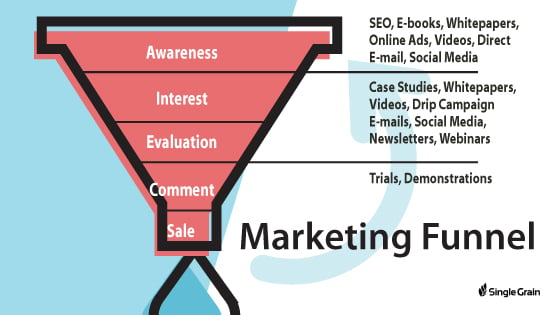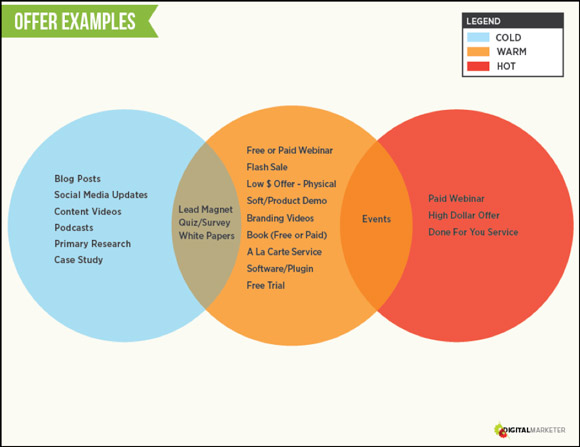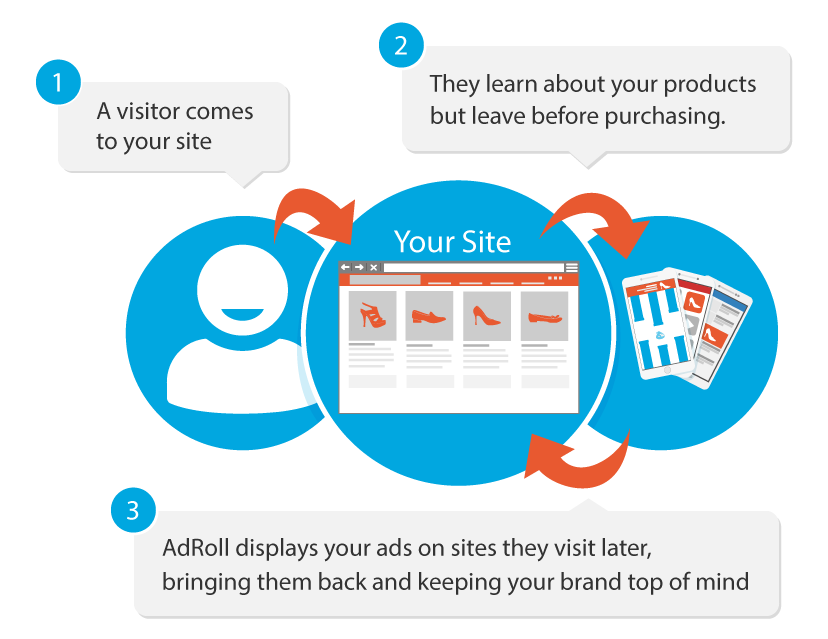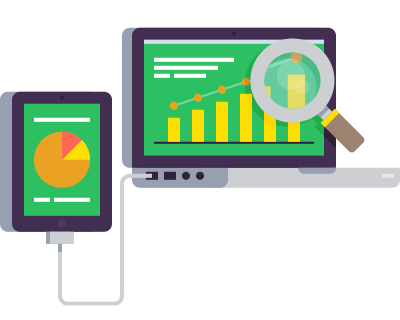NOW UPDATED! This post was updated in July 2017 with new information about retargeting your prospects. Enjoy!
Let’s talk about why you should be retargeting.
But first off…
What Is Retargeting?
Have you ever visited a website and then later you start seeing banners for that website following you around all over the web?
That’s remarketing — or retargeting. People use those words interchangeably.
It’s when you go on a website like Amazon and they put a cookie on your computer. So no matter where you go on the web, they will pixel you, and can they show you ads related to the web pages you were on when you visited Amazon.
A couple years ago when retargeting was first introduced it was still the Wild West, and there were companies like AdRoll that would sell you on retargeting. Now companies like Facebook, Google and Twitter allow you to retarget people directly from their platform.
The two main goals for retargeting ads are to drive/maintain awareness or to drive conversions. Adding this strategy to your marketing arsenal gives you the space to create direct, unique, and personalized ads. The ads that will produce the high clickthrough rates you are looking for.
Here are a few web advertising stats to keep in mind before we dive into the next sections:
- 71% of consumers prefer ads tailored to their interests and shopping habits
- Consumers are twice as likely to click on an ad for unknown product or brand if it’s personalized
- 44% of respondents to this study were willing to give up personal info (e.g. name and email address) in order to receive more personalized ads
[su_note]Free Marketing Funnel Maps: Get this FREE resource on how to map out each stage of your marketing funnel. Click here to download it free.[/su_note]
Serve Your Visitors Info that’s Actually Relevant to Them
Let’s say, for example, that you have a marketing site and a visitor clicks on an SEO link. They’re going to be placed on the SEO list. Or let’s say they clicked on PPC. They would be placed on the PPC list, and they would receive e-mails for whatever they’ve just demonstrated that they’re interested in.
This is why retargeting can be even better than setting up a funnel to segment visitors into e-mail lists. While funneling can be extremely effective, it’s still impersonal. You have to use one-size-fits-all messaging for your funnel.
Additionally, you are constantly building something of value with the audience data.
Before retargeting, you had to create your own marketing strategies based on audience analytics and market research. Now you can continue the conversation, without the need of a an email or phone number from the potential lead. This is a much more effective method for warming up cold traffic into leads.
With retargeting, you’re automatically serving your visitors stuff that’s actually relevant to them. Click To Tweet
You also have a lot of options when it comes to retargeting strategies. It’s not as simple as, “Well, if they hit a product page, I’m just gonna follow them around with that banner.” That might be standard for a lot of e-commerce sites, but it’s not optimized.
Let’s go back to our marketing agency example. Let’s say a visitor reads one of your blog posts and the topic was about marketing funnels. You can follow them around on the net, and perhaps you can give them a marketing funnel e-book.
Related Content: The Ultimate Guide to Creating Your Marketing Funnel
Then, once they opt in through the e-book, they’re placed onto another pixel on Facebook. Now Facebook knows these people have opted in for the e-book (probably a warm lead). The next step might be to catch them with a webinar or get them to buy a product.
[su_note]Free Marketing Funnel Maps: Get this FREE resource on how to map out each stage of your marketing funnel. Click here to download it free.[/su_note]
Retargeting Is an Essential Component of Marketing Funnels
The idea behind any marketing funnel is to move people down through the various stages, right?

Here’s the thing—a lot of people on your site aren’t going to convert. Maybe 99% aren’t going to buy on their first visit, so you need to follow them around and make sure they come back into the funnel at the right stage.
The key with remarketing when you’re doing a campaign is to show your lead something different. If someone comes to your homepage and they don’t convert, when you do a remarketing campaign, do you think you should send them back to your homepage? No!
Sure, every once in a while you might drive sales from doing that, but you’re way better off retargeting that lead and sending them to a unique page they haven’t seen before.
Related Content: 5 Case Studies of Successful Marketing Funnels
Retargeting Is Kind of Like Dating
If you go up to a random girl or guy and say, “Will you marry me?” chances are they’re going to say no. And possibly hit you.
But if you ask that same random person, “Hey, I think you’re cute, would you like to go on a coffee date?” Let’s say they say yes and the coffee date goes well. From there, you guys go on a few more dates, get serious, eventually move in together, and finally someone pops the question. At this point, there’s a much higher chance that they’ll say yes when you ask them to marry you.
As with dating, the key to marketing is building relationships and trust. Retargeting works in a similar way. Someone comes to your website, they don’t buy, you remarket to them, and they keep seeing your ads everywhere. The “rule of seven” works well with remarketing because when someone sees something 7 times, they’re much more likely to buy.
Earn your site visitors and potential customers’ trust by making them comfortable with you, then get them back to the site, educate them more through blog posts, webinars, training materials, e-mail follow-up sequences, and then ask them to buy.
They’re much more likely to convert.
Learn More: The Ultimate Guide to Drip Campaigns
How to Segment and Retarget Cold Traffic
Let’s put this back into a marketing context for a second. Google “Digital Marketer traffic temperature.” OK, fine, I’ll do it for you. You will see this Venn diagram based on cold traffic, warm traffic and hot traffic:

(Source)
Cold traffic is when people who have never heard of your brand before and have never engaged with you before visit your site. You want to drive them to a blog post or something like that. Get them to learn a little bit about you. Maybe give them a little value from your blog post. Your “free” content gift could be a blog post, a webinar, an e-book, a case study or a video training.
Worst case scenario, you can pixel them. If they land on your blog post, you’re able to pixel them, you’re able to retarget them from Google, you’re able to retarget them from Facebook. And you’re able to do a lot with those pixels. With Google, you can build smart audiences, or lookalike audiences, from people who have visited specific sections. Same thing with Facebook, you can build lookalike segments as well.
A lookalike segment is when you say, “Hey Facebook, go and find people on Facebook that have similar interests to these people who visited a specific section on my site.” Facebook’s algorithms will build an audience based on 1% lookalikes, which is usually around 2 to 2.5 million people.
If you think about it, the bare minimum that you’ll get is a pixel assigned to a visitor and it’s already pretty good. If a visitor downloads an e-book, for example, they’re automatically moved into a “warm leads” segment. These are the people who will most likely pay for a service, and you can retarget them whenever and however you want.
Learn More: Here’s How Targeting Cold, Warm & Hot Traffic Builds Successful Customer Relationships
[su_note]Free Marketing Funnel Maps: Get this FREE resource on how to map out each stage of your marketing funnel. Click here to download it free.[/su_note]
When Not to Retarget
Case in point: I don’t generate too many sales from South America. I have a good amount of traffic from South America, but I make sure that I’m not remarketing them, because that money would be better spent elsewhere.
Sure, the remarketing traffic costs for South America are way more affordable than remarketing costs for the U.S., UK, Canada, Australia, etc. But if they’re not going to convert into sales, why spend any time retargeting them in the first place?
The same applies if, say, you have a coffee shop in Seattle, Washington. Why would you re-market to people in California? By doing that, you’re just going to get a ton of people going to your website that won’t ever buy anything or stop at your coffee shop.
One thing you should also be aware of is “over targeting” your audience.
Retargeting about staying on the mind of your target. Think of it as a little reminder that they visited your site; not a flamboyant grab for attention. Going back to the dating analogy, you wouldn’t text someone non-stop after the first date, would you? (Unless you hit it off super fast then hey, you just converted your first date into a relationship!)
Likewise, saturating a fresh target with ads can become a turnoff. You don’t want to take over someone’s browsing experience. There’s a fine line between retargeting tactfully and bombarding.
Retargeting Ideas for Various Funnel Stages
If we think of retargeting as finding ways to maintain and sustain product interest, then–if done correctly–retargeting ads can be implemented throughout of the marketing funnel. Here are few ideas of possible ads to run at all stages of the funnel:
- Awareness. Generic ads with logo, but slightly different from ads that you run to audiences who have yet to visit your site. Ads giving free value are also good at this stage (e-books, blog posts, white papers etc.)
- Interest. Ads specific to pages they have visited, or products they have clicked on in your site. Something that triggers their most recent visit. Giving away free value is good at this stage too, as long as it’s specific to what they seem to be looking for when they visit your site.
- Evaluation. Ads that overcome objections.
- Comment. Promotions or urgent discounts.
- Sale and Post-Sale. Ads of related products, retention-based ads, or other services that you offer.
When creating your ads think about those buyer personas. Where does your audience live? How old are they? What are their interests? Use this info to inform and personalize your ad copy.
Retargeting ads can and should be fun. Always remember that since the audience has somewhat of an awareness of you already, what worked before won’t work the next time. And the next time, and the next time–for each level deeper into the funnel. Therefore, do something that will grab their attention.
The more you know your audience the better you can do this. Next thing you know you’ll have customers saying, “It’s almost as if they read my mind and knew exactly what I wanted.”
That’s when you know you’re killing the game.
[su_note]Free Marketing Funnel Maps: Get this FREE resource on how to map out each stage of your marketing funnel. Click here to download it free.[/su_note]
Should You Work with Retargeting Companies?
You can use the AdRolls of the world, but they don’t have the inventory of Google or Facebook. If I was starting off, I would just use Google and Facebook. They’re going to be the majority of your impressions, inventory clicks and traffic. When you’ve mastered Google and Facebook, then you can start talking to the AdRoll-type of companies.
Learn More: How to Set Up a High-Converting Facebook Retargeting Campaign
But be careful. When you talk with the reps, they make it sound like it’s all sunshine and rainbows. “Oh, wow. Your cost per acquisition is amazing. It’s $5 and you told us your target was $50. That has to be amazing, right?”
Here’s the thing — when they’re giving you those numbers, they’re looking at the “view through conversion” metric. That’s somebody who actually saw your banner but didn’t directly convert. They may have gone back to your website at a later date for a totally different reason, but the rep will still count that as a conversion.
That’s what Neil and I call a bullshit metric.
Final Note
As with all aspects of digital marketing, retargeting is a commitment. It may take a few months to see any ROI. And you’ll probably have to test and tweak your messaging continuously after that.
It can be tempting to just reuse old ad formats from previous campaigns. But chances are, your target audience may have already came across these, so you’ll have to be a bit more unique.
The good thing though is that your ads will only get better as your come to know your audience. And due to to the highly personal nature of this kind of marketing, you’re sure to get a high percentage of MQLs to your site.
Google and Facebook are so great for retargeting that you can actually upload your e-mail list and target those specific people immediately. Now imagine if you had a buyers’ list, where everybody has purchased already. Well guess what? You can make a lookalike off that buyer list, and you can retarget that buyer list, and then hit them with higher ticket offers.
Let’s say a buyer bought something from you for $500. Maybe the next upsell is $5,000. And then after that, maybe it’s $50,000. You can bring them further and further down through your funnel and get them to convert time and time again.
So that’s what I want to leave you with on the subject of retargeting.
This post was adapted from Marketing School, a 10-minute daily podcast in which Neil Patel and Eric Siu teach you real-life marketing strategies and tactics from their own experience to help you find success in any marketing capacity. Listen to the podcast version of this post below:


